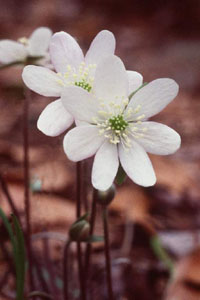

Hepatica, called Liverwort or Liverleaf, is a perennial herb four to eight inches tall, growing in moist, shaded woods and blooming in February to April. The solitary long-stalked flowers emerge through last year's bronzed and decaying leaves.
The six to ten delicate "petals" are actually sepals which vary in color from white to bluish or pinkish. The sepal-like structure beneath them is actually bracts which are persistent. Numerous stamens arise around the yellow to green dome-like center of the flower.After the "petals" fall, many new dark green leathery 3-lobed leaves appear. These leaves originally inspired the botanical and common names. In both the shape and winter color of the leaves, early herbalists saw a resemblance to the human liver.
The Greeks called the plant hepar, meaning "liver", and they used it to treat disorders of that organ. They also employed it to treat what they believed were symptoms of liver disease: cowardice, freckles or indigestion. This is a classic example of the "doctrine of signatures", where the plant's outward appearance provides a divine sign of its healing properties. This doctrine had a great following among medieval physicians.
